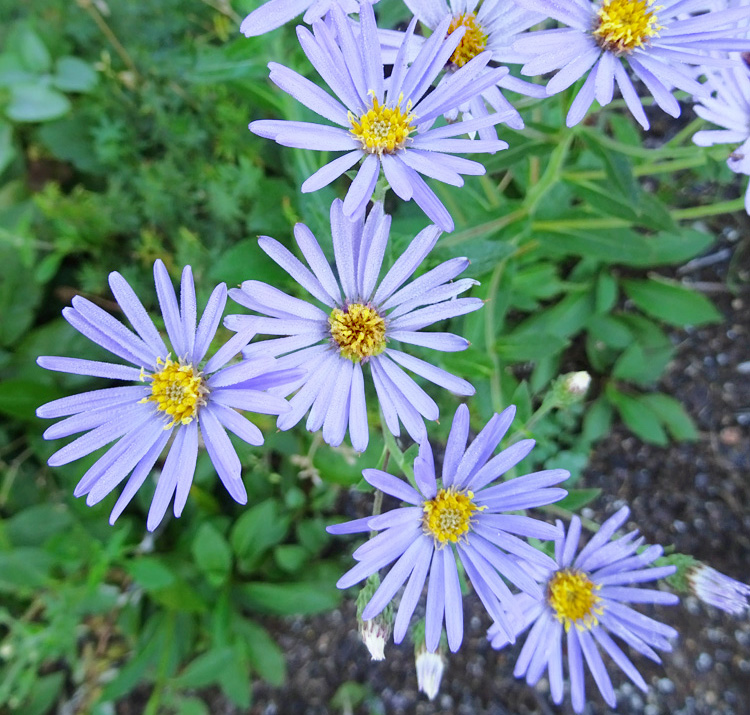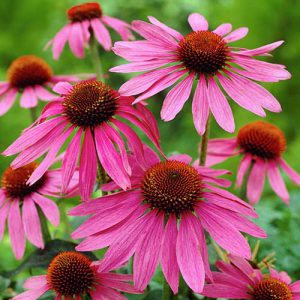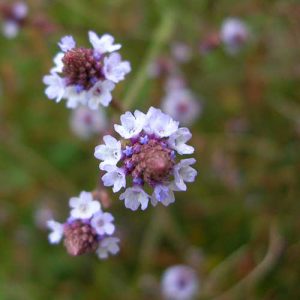Aster macrophyllus
TWILIGHT ASTER
Syn. Eurybia macrophyllus
Aster macrophyllus has lovely twilight shades of blue, hence the common name of Twilight Aster. It is a fine Easter Daisy.
Twilight shades of misty blue
So Aster macrophyllus produces clouds of misty lavender-blue small daisies, with fine ray petals. It is a super star for prolific flower production.
And it makes an excellent cut flower too.
(Scroll down to “Growing” section for plant details & how to grow).
Fine appearance hides a tough constitution
However it’s delicate appearance disguises a tough constitution. It is actually ultra-hardy.
Because it comes from a native habitat amongst trees and shrubs in open woodland.
So it is not a bit fussy, and is very tolerant of poorer soils, including clay, as well as frosts and humidity.
And it can also cope with periods of dry, particularly if it gets some shade.
Good groundcover, especially on slopes
Aster microphyllus is an effective groundcover on slopes, where it can help stabilize the soil. Plus it is hardy, easy and low maintenance.
SEED SOWING ADVICE: QUICK & EASY
Suitable for beginners & gardening with kids
Sow seeds any time indoors in punnets, or scatter seeds directly in garden in autumn or early spring.
Sow indoors for quick plants & early flowers: Sow the seeds on surface of good quality seed raising mix.
Then barely cover the seeds with mix / vermiculate / fine grit, to a maximum of their own diameter. Because these seeds need light to germinate.
Keep the punnet moist, in a warm, well-lit position.
Temperatures of 20-21C are idea for rapid and optimum germination. But these seeds are easy to germinate.
Seedlings emerge in approx. 10-12 days.
Seed Count: 30 seeds per pack approx.
(We always aim to exceed the stated seed count, and give a generous serve).
GROWING: Aster macrophyllus
– Height with flowers: Blooms in heads on strong, upright stems to 60cm. approx.
– Width: Creates a dense carpet of heart shaped leaves. It gently spreads to reach a diameter of 60-75cm. approx.
– Position: Aster macrophyllus is very obliging and easily pleased.
So it is happy in either Full Sun or Part Shade.
And can cope well with periods of dry in either location. It is of course perfectly happy with some shade, as a native of wood and scrublands.
It can also tolerate humidity well, unlike many other Asters.
Tough & hardy
– Soil: Again the Twilight Aster is easily pleased. It copes in a wide range of soils, from light and sandy, rocky and gravel, to clay based. Neither is it particularly fussy about soil pH. So it can tolerate soils on either the acid or alkaline lime side of neutral. Although it does ask for good drainage.
– Water-wise: Aster macrophyllus is not a thirsty plant. So it can tolerate some periods of dry in either sun or shade. And normal, average garden watering is ample.
– Frost: The Twilight Aster is exceptionally frost hardy, as it can tolerate severe frosts to well below -20C.
– Growth: A perennial which gently spreads by rhizomes to form a groundcover of heart shaped foliage. The underground rhizomes give it hardiness and resistance to difficult conditions.
Easy low care
– Beneficial for wildlife: Bees and butterflies are very happy foraging for nectar and pollen in the abundant flowers. The late summer and autumn flowering season is also a help to them. As Twilight Aster blooms at a time of the year when fresh flowers can be scarce.
– Care: Very easy low care.
With the only work being to shear back the spent flower stems to the ground after flowering.
Aster macrophyllus is generally pest and disease free.
And blessedly it is free from attack by mildew, which blights some of the old hybrid Asters.
– Deer & Rabbit resistant: Both rabbits and deer tend to put this Aster low on their foraging list, and steer away from it unless they are starving.
– Origin: Aster macrophyllus is found in beech and maple woodlands, sandy groves under oak trees, on shaded sand dunes, and shaded edges of woodlands, in the East of North America.
Click here for Nursery Open Days & Open Gardens Information
https://www.gardivalia.com.au/open-gardens
Click here to go back to Seeds Shop
https://www.seedscape.net.au/shop/
Related products
-
Add to WishlistAlready In WishlistAdd to Wishlist
-
Add to WishlistAlready In WishlistAdd to Wishlist
-
Add to WishlistAlready In WishlistAdd to Wishlist
-
Add to WishlistAlready In WishlistAdd to Wishlist





